Sunday, May 28, 2006
Part 1: 10-days of diving in Fiji with Nai'a
I just love the video display that you get on international flights that let's you know exactly where you are. On our Air Pacific flight from LA to Fiji each person had their own display in the back of the seat in front of them. It doesn't photograph very well, but here ya go. This was taken just before we landed in Fiji (approx 23 hrs after we left home). You can see that we are a ways below the equator and just on the other side of the International Date Line.
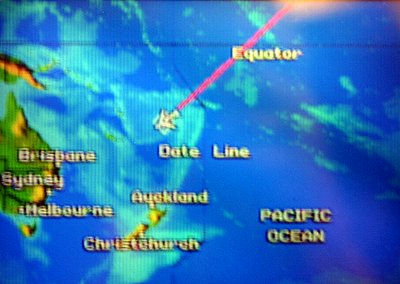
Here's Mom and Jim as we arrived at the Nadi (pronounced Nandy) airport with the full moon overhead. It was very early in the morning.
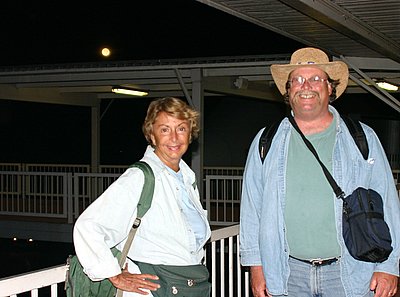
We checked in to a nearby hotel for a day room so we could get some more sleep before getting on the ship in the afternoon. When we woke up we still had time for a little walk. Notice the thatched roof bus stop - and the fact that they drive on the left. Fiji used to be a British Colony ... they won their independence in 1970.
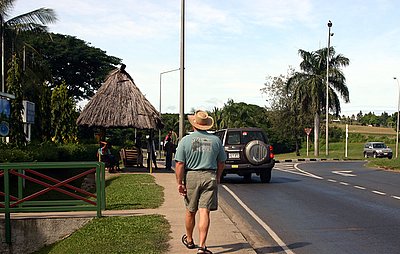
Come to find out, Fiji was in the midst of their national elections. We think this was why our transportation was delayed. Every bus and taxi was busy taking voters to the polls. So, we arrived at the Nai'a almost 2 hours late. They headed out right away to get us to the dive site for our check-out dive. Since it gets dark at 6, the checkout dive turned into a night dive. Here's the skiff coming back in after the dive.
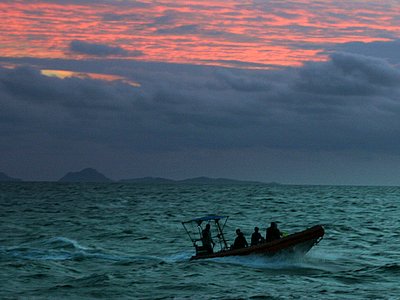
According to my careful calculations, 6pm in Fiji would be midnight Florida time, so our bodies were sure this was a night dive! After that, we had our welcome aboard the Nai'a and a full dinner. I can't say I remember much of that since I was just trying to keep my face out of my soup, but here's a picture of the delightful crew welcoming us aboard with some island music. There were 13 crew, and 13 passengers. Nice odds huh?
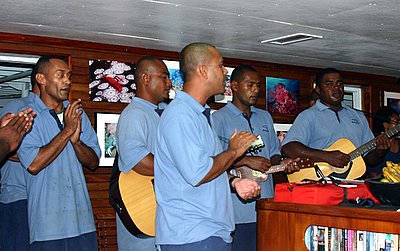
The next morning we were treated to another view of the full moon.
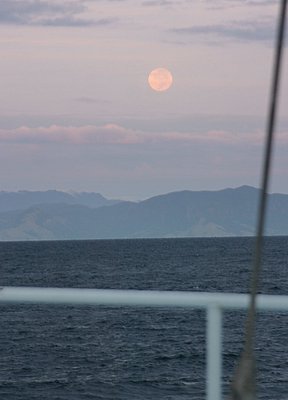
The first dive was at 7:30. Nai'a operates differently than most dive boats I've been on - Caribbean mostly. The main ship anchors away from the reef, then the skiffs are loaded with our dive tanks. The divers get in the skiffs and are taken to the dive site just a short distance away. We do a simple back roll off the skiffs to start the dive. At the end of the dive, you just come up wherever you happen to be and the skiff will be there waiting for you! You take off your BC/tank and the skiff driver will haul it into the boat. Then you haul yourself in. At first I needed help. The skiff driver had to grab a handful of my wetsuit and haul me up like a cat grabbing a kitten by the scruff of the neck. It didn't take long though before I could grab the line and pull myself up, then straighten my elbows to launch my body up on top of the side of the boat - then I just flop like a fish until I'm fully inside the boat. Too bad we don't have video of that!
Here's the skiff:
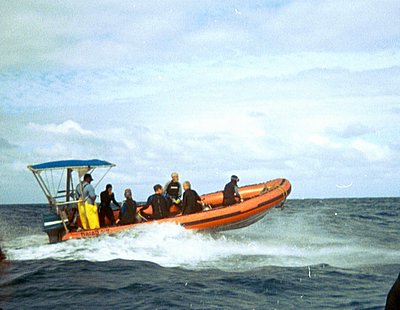
The weather was poor for the first part of the trip. It actually rained just once, but it was overcast and windy. Very windy. Didn't bother us much underwater, but it made the skiff rides pretty adventurous. And, boy was I glad for the *hot* shower on deck where we took our wetsuits off - that wind felt cold. May in Fiji is fall weather, they're just heading into their winter season. The water was 80-82 degrees, plenty warm, but still I needed my shorty wetsuit over my skin to be comfortable. The air temperature was about the same, but with the wind it sure felt colder. When we came up from a dive, we would take that nice hot shower on deck, then quickly go below and get dried and into dry clothes.
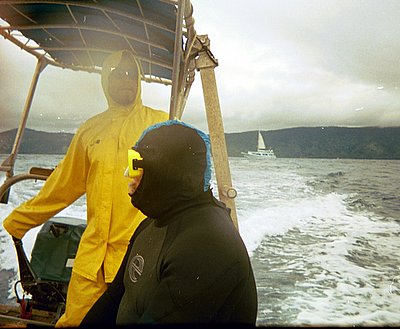
I think the best part about Fiji diving is that the reefs usually come up to about 15 feet below the surface. They may drop down a sheer wall to 3,000 feet, but the corals grow and build to just below the surface. In case you're not a scuba diver, this is important for two reasons: 1)you can stay down longer. Because of the physiology of scuba diving, the deeper you go, the shorter your dive. At 15 feet, you have no time limitation, you can stay until your air runs out. For us that was usually just over an hour. 2) there's more light to see stuff. Here's what we see at 15 feet in Fiji:
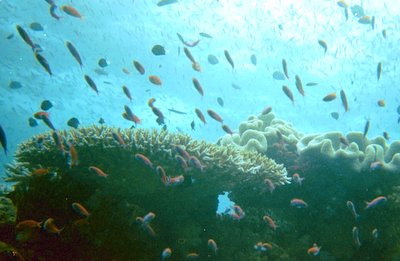
For underwater photos, I just had a $20 camera I picked up in a dive shop. I didn't get any photos that are very good, but you should be able to get the idea anyway.
You see things in the Pacific that don't live in the Atlantic. Anemone fish, aka Clown Fish, aka Nemo, are *the cutest*. The way they snuggle into their anemones just makes you want to pat them on the head! Both Mom and Jim took video, hopefully I'll have some clips to post of snuggling anemone fish later.
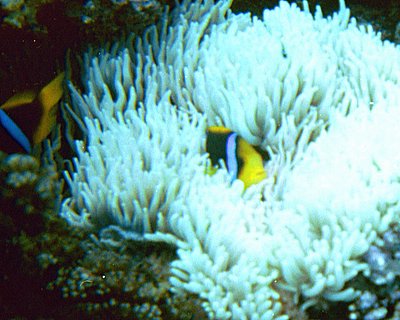
Before every dive, our divemaster/cruise directors Josh or Liz, would draw a diagram of the dive site we're about to visit and tell us how to dive it and what to expect. One of the divemasters was always underwater with us. You have the option to follow them, or you can take off on your own. So, being briefed on the site is very welcome. Here's Mom reviewing the diagram with Liz.
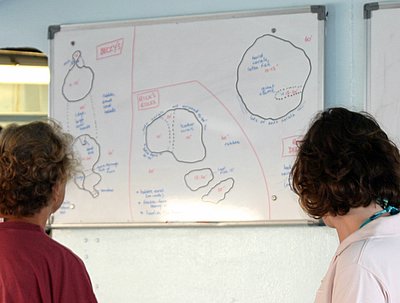
Another white board let us know what our schedule was every day. Basically each day consists of dive, eat, dive, eat, dive, eat, dive, eat and maybe one more dive. According to Josh it boils down to this: if you're wet, it's time to eat. if you're full, it's time to dive! And the food was gourmet wonderful delicious!
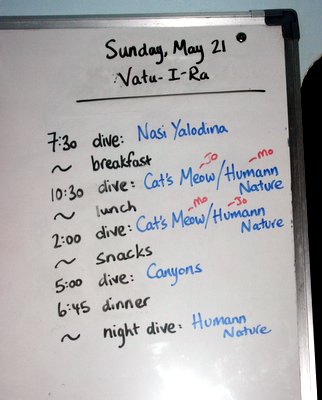
Our cabin was spacious and well-appointed. A full sink/bathroom/shower in the room. And a porthole to see outside. I've never been more comfortable on a liveaboard.
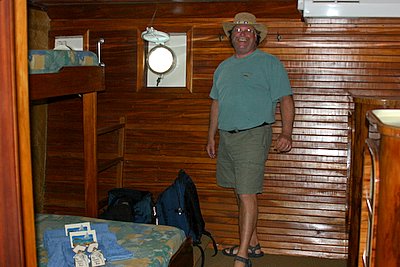
OK, back to the diving. The most unusual dive site was Nigali Passage. A passage is a cut in a barrier reef where the tides go in and out so it has to be timed right. We want to dive while the tide is flowing in thru the passage because that's clear ocean water. When the tide is going out, it's 'flushing' the lagoon of the dirtier water. In this passage, you see lots of sharks if you just hang out a while. Here's a group of us hanging out. The current was pretty stiff. To hang out for any length of time, you need to find some dead coral that you can hang on to.
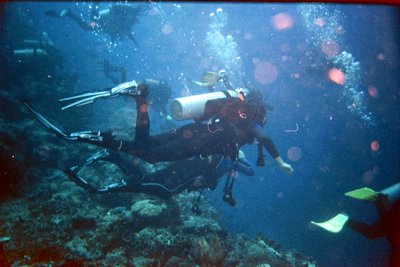
We saw lots of sharks, but I didn't get a good enough picture to post. To see some good pictures go to the Nai'a photo page . Specifically, the last photo on the last photographer's page is of sharks in Nigali Passage. >Burt Jones & Maurine Shimlock
I did get some decent shots of the snake tho. Believe it or not, this guy is deadly poisonous. But, divers have learned how docile they are. I just thought s/he was beautiful.
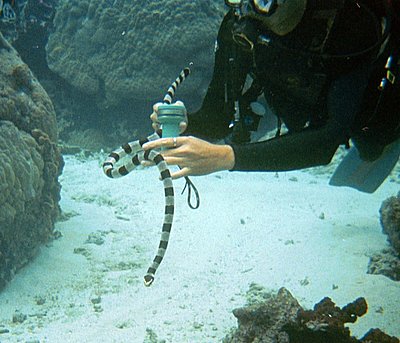
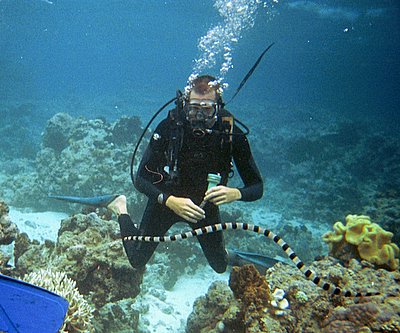
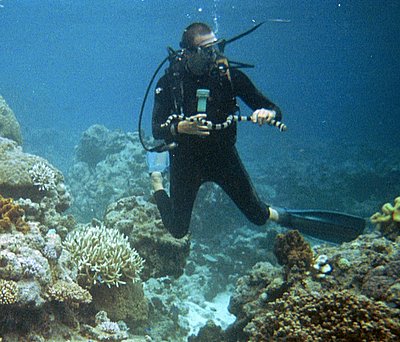
more later...
Here's Mom and Jim as we arrived at the Nadi (pronounced Nandy) airport with the full moon overhead. It was very early in the morning.
We checked in to a nearby hotel for a day room so we could get some more sleep before getting on the ship in the afternoon. When we woke up we still had time for a little walk. Notice the thatched roof bus stop - and the fact that they drive on the left. Fiji used to be a British Colony ... they won their independence in 1970.
Come to find out, Fiji was in the midst of their national elections. We think this was why our transportation was delayed. Every bus and taxi was busy taking voters to the polls. So, we arrived at the Nai'a almost 2 hours late. They headed out right away to get us to the dive site for our check-out dive. Since it gets dark at 6, the checkout dive turned into a night dive. Here's the skiff coming back in after the dive.
According to my careful calculations, 6pm in Fiji would be midnight Florida time, so our bodies were sure this was a night dive! After that, we had our welcome aboard the Nai'a and a full dinner. I can't say I remember much of that since I was just trying to keep my face out of my soup, but here's a picture of the delightful crew welcoming us aboard with some island music. There were 13 crew, and 13 passengers. Nice odds huh?
The next morning we were treated to another view of the full moon.
The first dive was at 7:30. Nai'a operates differently than most dive boats I've been on - Caribbean mostly. The main ship anchors away from the reef, then the skiffs are loaded with our dive tanks. The divers get in the skiffs and are taken to the dive site just a short distance away. We do a simple back roll off the skiffs to start the dive. At the end of the dive, you just come up wherever you happen to be and the skiff will be there waiting for you! You take off your BC/tank and the skiff driver will haul it into the boat. Then you haul yourself in. At first I needed help. The skiff driver had to grab a handful of my wetsuit and haul me up like a cat grabbing a kitten by the scruff of the neck. It didn't take long though before I could grab the line and pull myself up, then straighten my elbows to launch my body up on top of the side of the boat - then I just flop like a fish until I'm fully inside the boat. Too bad we don't have video of that!
Here's the skiff:
The weather was poor for the first part of the trip. It actually rained just once, but it was overcast and windy. Very windy. Didn't bother us much underwater, but it made the skiff rides pretty adventurous. And, boy was I glad for the *hot* shower on deck where we took our wetsuits off - that wind felt cold. May in Fiji is fall weather, they're just heading into their winter season. The water was 80-82 degrees, plenty warm, but still I needed my shorty wetsuit over my skin to be comfortable. The air temperature was about the same, but with the wind it sure felt colder. When we came up from a dive, we would take that nice hot shower on deck, then quickly go below and get dried and into dry clothes.
I think the best part about Fiji diving is that the reefs usually come up to about 15 feet below the surface. They may drop down a sheer wall to 3,000 feet, but the corals grow and build to just below the surface. In case you're not a scuba diver, this is important for two reasons: 1)you can stay down longer. Because of the physiology of scuba diving, the deeper you go, the shorter your dive. At 15 feet, you have no time limitation, you can stay until your air runs out. For us that was usually just over an hour. 2) there's more light to see stuff. Here's what we see at 15 feet in Fiji:
For underwater photos, I just had a $20 camera I picked up in a dive shop. I didn't get any photos that are very good, but you should be able to get the idea anyway.
You see things in the Pacific that don't live in the Atlantic. Anemone fish, aka Clown Fish, aka Nemo, are *the cutest*. The way they snuggle into their anemones just makes you want to pat them on the head! Both Mom and Jim took video, hopefully I'll have some clips to post of snuggling anemone fish later.
Before every dive, our divemaster/cruise directors Josh or Liz, would draw a diagram of the dive site we're about to visit and tell us how to dive it and what to expect. One of the divemasters was always underwater with us. You have the option to follow them, or you can take off on your own. So, being briefed on the site is very welcome. Here's Mom reviewing the diagram with Liz.
Another white board let us know what our schedule was every day. Basically each day consists of dive, eat, dive, eat, dive, eat, dive, eat and maybe one more dive. According to Josh it boils down to this: if you're wet, it's time to eat. if you're full, it's time to dive! And the food was gourmet wonderful delicious!
Our cabin was spacious and well-appointed. A full sink/bathroom/shower in the room. And a porthole to see outside. I've never been more comfortable on a liveaboard.
OK, back to the diving. The most unusual dive site was Nigali Passage. A passage is a cut in a barrier reef where the tides go in and out so it has to be timed right. We want to dive while the tide is flowing in thru the passage because that's clear ocean water. When the tide is going out, it's 'flushing' the lagoon of the dirtier water. In this passage, you see lots of sharks if you just hang out a while. Here's a group of us hanging out. The current was pretty stiff. To hang out for any length of time, you need to find some dead coral that you can hang on to.
We saw lots of sharks, but I didn't get a good enough picture to post. To see some good pictures go to the Nai'a photo page . Specifically, the last photo on the last photographer's page is of sharks in Nigali Passage. >Burt Jones & Maurine Shimlock
I did get some decent shots of the snake tho. Believe it or not, this guy is deadly poisonous. But, divers have learned how docile they are. I just thought s/he was beautiful.
more later...
posted by Chris at 5/28/2006 10:52:00 AM
Links to this post:
1 Comments:
Your are Excellent. And so is your site! Keep up the good work. Bookmarked.
»
»